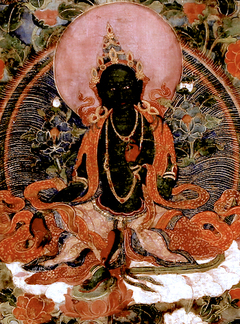Tārā Pacifying Fear of Natural Disasters
༁ྃ༔ ས་ཡི་འཇིགས་པ་ཞི་བའི་ཐབས།
A Means to Pacify the Fear of Natural Disasters
by Jamyang Khyentse Chökyi Lodrö
ས་ཡི་འཇིགས་པ་ཞི་བའི་ཕྱིར༔
sa yi jikpa zhiwé chir
In order to pacify the fear of natural disasters,
རང་ཉིད་རྡོ་རྗེ་སྒྲོལ་མ་མཐིང་༔
rangnyi dorjé drolma ting
I appear as Vajra Tārā, blue in colour—
ཕྱག་གཡས་མཆོག་སྦྱིན་གཡོན་པ་ནི༔
chak yé chok jin yönpa ni
Her right hand in the gesture of supreme generosity,
སྐྱབས་སྦྱིན་ཕྱག་རྒྱས་ཨུཏྤལ་ལ༔
kyab jin chakgyé utpal la
Her left in the mudrā of granting protection
རྡོ་རྗེ་རྩེ་ལྔས་མཚན་པ་བསྣམས༔
dorjé tsé ngé tsenpa nam
And holding an utpala topped by a five-pronged vajra.
དར་དང་རིན་ཆེན་རྒྱན་གྱིས་བརྒྱན༔
dar dang rinchen gyen gyi gyen
She is adorned with the silk and jewel ornaments.
གནས་གསུམ་བྱིན་རླབས་ཡེ་ཤེས་བསྟིམ༔
né sum jinlab yeshe tim
Blessings and wisdom enter my three centres;
དབང་བསྐུར་མཆོད་བསྟོད་གསོལ་བ་གདབ༔
wangkur chötö solwa dab
I am empowered; I present offerings, offer praise and pray.
ཐུགས་ཀར་ཟླ་སྟེང་ཏཱྃ་མཐིང་ག༔
tukkar da teng tam ting ga
At the deity’s heart, upon a moon disc is the blue syllable Tāṃ
མཐའ་བསྐོར་སྔགས་ཀྱི་ཕྲེང་བས་བསྐོར༔
ta kor ngak kyi trengwé kor
Surrounded by the mantra garland,
འོད་ཟེར་རྡོ་རྗེའི་རང་བཞིན་འཕྲོས༔
özer dorjé rangzhin trö
Which emanates rays of light, all with the nature of the vajra,
འཕགས་མཆོད་འགྲོ་བའི་དོན་ཀུན་བྱས༔
pak chö drowé dön kün jé
Presenting offerings to noble ones and working for beings’ welfare.
ཁྱད་པར་ང་རྒྱལ་ལས་གྱུར་པའི༔
khyepar ngagyal lé gyurpé
In particular, I consider that the rays pacify all fears of natural disaster,
ས་ཡི་འཇིགས་པ་ཀུན་ཞི་བསམ༔
sa yi jikpa kün zhi sam
Which originate from a sense of self-importance.
རྩ་སྔགས་ཡི་གེ་བཅུ་པའི་མཐར༔
At the end of the ten-syllable root mantra
མ་མ་སརྦ་ལཾ་ལཾ་བྷ་ཡ་ཤཱནྟིཾ་ཀུ་རུ་ཞེས་པ།
Affix mama sarva laṃ laṃ bhaya śāntiṃ kuru
སྭཱ་ཧཱའི་གོང་དུ་སྤེལ།
Before svāhā, which has an enhancing effect:
ཨོཾ་ཏཱ་རེ་ཏུཏྟཱ་རེ་ཏུ་རེ་མ་མ་སརྦ་ལཾ་ལཾ་བྷ་ཡ་ཤཱནྟིཾ་ཀུ་རུ་སྭཱ་ཧཱ།
om taré tuttaré turé mama sarva lam lam bhaya shanting kuru soha
oṃ tāre tuttare ture mama sarva laṃ laṃ bhaya śāntiṃ kuru svāhā
འདི་ཡང་འཇམ་མགོན་རྡོ་རྗེ་འཆང་གི་དགོངས་གཏེར་ཡིན་ནམ་ཅི་ཡིན་མ་ངེས། འདི་སྔོན་ཚེ་ས་གཡོས་འཇིགས་པ་ཉིན་རེ་ལའང་ཐེངས་བརྒྱད་དགུ་འོང་བའི་སྐབས་སུ་སློབ་གྲྭ་རྣམས་ལ་འདི་འདོན་གསུངས་ནས་གནང་བ་རེད།། །།
Editor’s note: It is uncertain whether this is Jamgön Dorje Chang’s mind treasure. In the past, at a time when there were terrifying earthquakes as frequently as eight or nine times a day, he gave the text to students and told them to recite it.1
| Translated by Adam Pearcey with the generous support of the Khyentse Foundation and Tertön Sogyal Trust, 2020.
Source:
'Jam dbyangs chos kyi blo gros. "sa yi 'jigs pa nyin rer thengs brgyad dgur 'ong skabs slob grwa rnams la ngag 'don du gnang ba/" in ’Jam dbyangs chos kyi blo gros kyi gsung ’bum. 12 vols. Bir: Khyentse Labrang, 2012. W1KG12986 Vol. 6: 347
Version: 2.0-20250225
- ↑ Although this note appears in the collected writings at this point, it is in fact clear that Khyentse Chökyi Lodrö took this liturgy entirely from a text that Jamgön Kongtrul compiled, which belongs to the Tārā Who Dispels All Fears sub-cycle in the Tukdrup Barché Kunsel cycle within the Chokling Tersar. See https://www.lotsawahouse.org/tibetan-masters/jamgon-kongtrul/tara-protect-fears-earth
